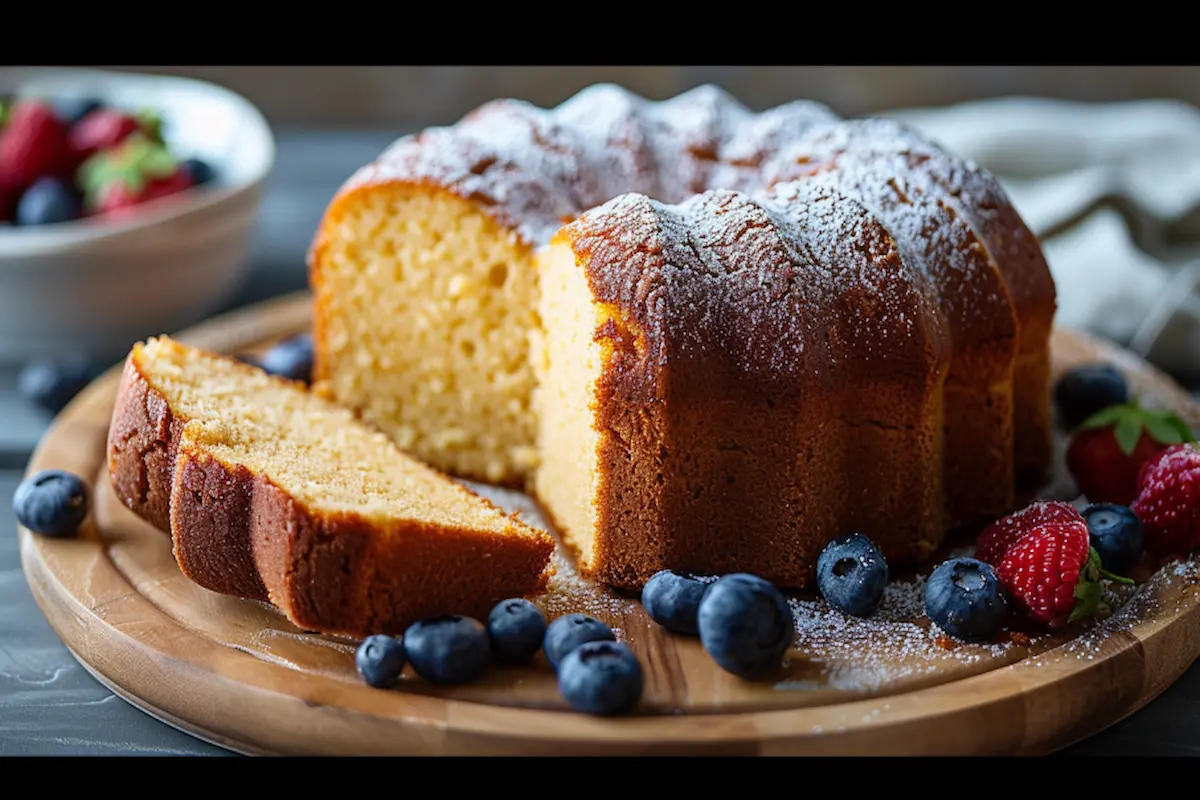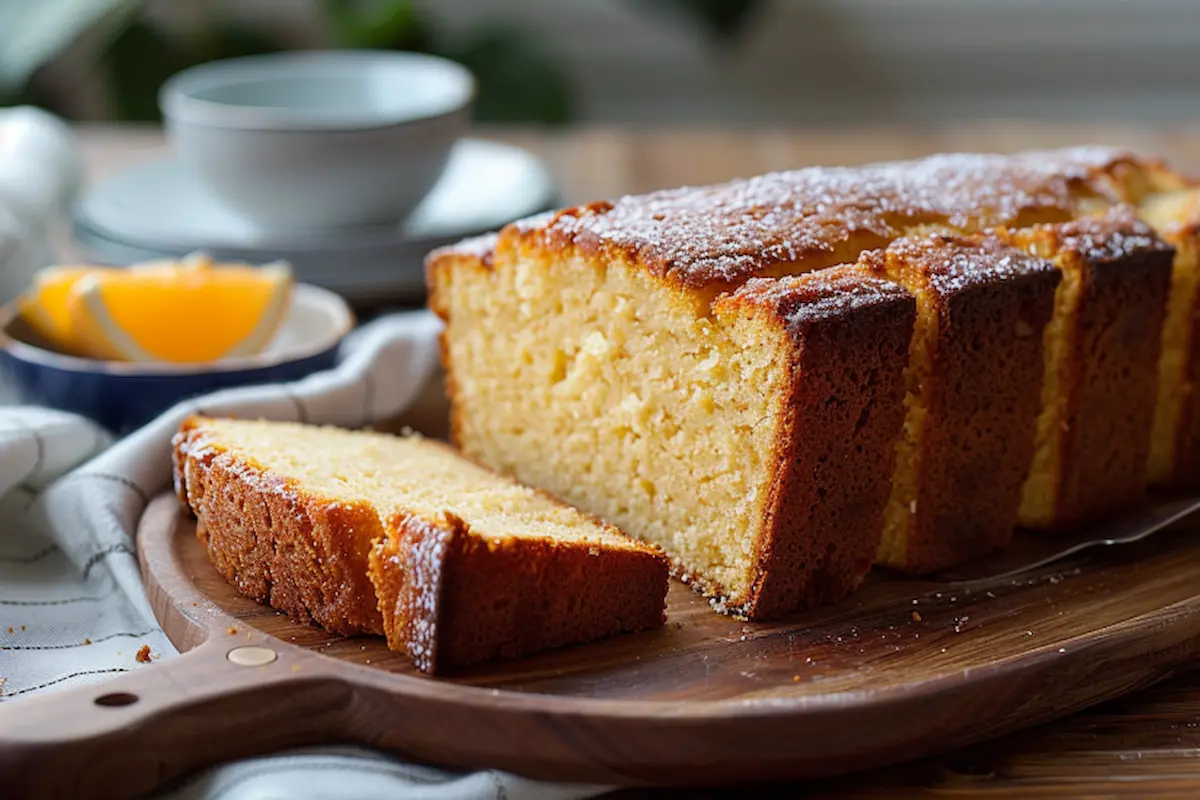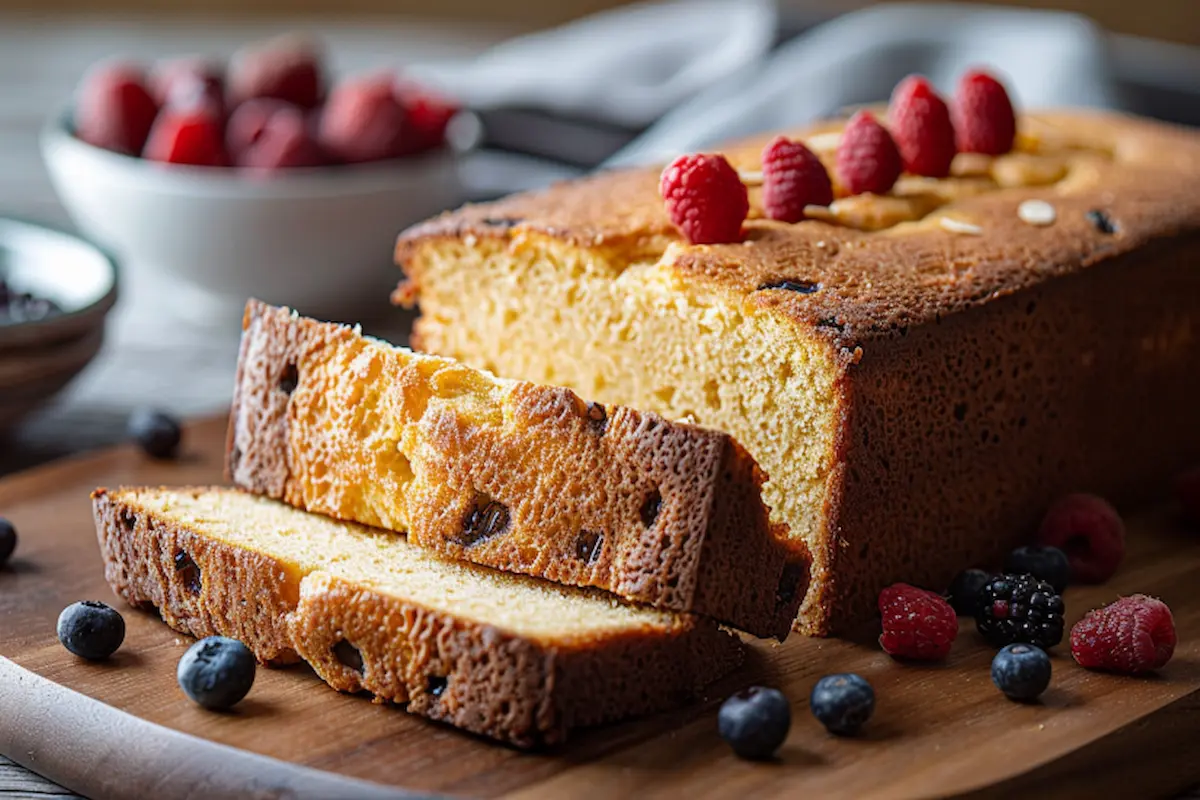London Pound Cake is a modern twist on the classic pound cake, beloved for its rich, buttery texture and versatile flavor profile. This cake has gained popularity not just in the UK but globally, becoming a favorite in both traditional and contemporary kitchens. In this comprehensive guide, we’ll explore the history, ingredients, variations, and expert tips to help you bake the perfect London Pound Cake. Along the way, we’ll also link to related recipes and baking tips from our extensive collection at Ollie Recipes.
The History of Pound Cake: A Timeless Classic
Pound cake is a dessert with a storied history, dating back to the early 18th century in Europe. The original recipe called for one pound each of flour, butter, sugar, and eggs, hence the name “pound cake.” This straightforward recipe made it easy to remember and replicate, contributing to its widespread popularity. Over time, variations of pound cake emerged, incorporating different flavors and ingredients, which led to the creation of modern versions like London Pound Cake.
At Ollie Recipes, we explore the evolution of desserts, such as in our Guide to Red Velvet Brownies, where we delve into how traditional recipes have been adapted and refined over the years.

What Sets London Pound Cake Apart?
London Pound Cake is distinguished by its unique blend of classic pound cake ingredients with modern flavor enhancements. The inclusion of lemon zest, vanilla bean, or even lavender gives this cake a fresh, aromatic twist that’s perfect for afternoon tea or a special occasion. The cake retains the dense, moist texture characteristic of traditional pound cake, but with a lighter, more sophisticated flavor profile.
For those interested in exploring other cake variations, our Marmalade Cake Recipes offers another delightful British-inspired dessert option.
Essential Ingredients for London Pound Cake
To create a London Pound Cake that’s both flavorful and tender, you’ll need high-quality ingredients. Here’s what you’ll need:
- Unsalted Butter: The cornerstone of any good pound cake, providing a rich, creamy base.
- Granulated Sugar: Balances the butter’s richness with sweetness.
- Large Eggs: Essential for binding the cake and adding structure.
- All-Purpose Flour: Gives the cake its characteristic dense crumb.
- Baking Powder: Ensures a slight rise, preventing the cake from becoming too heavy.
- Whole Milk: Adds moisture, making the cake tender and soft.
- Pure Vanilla Extract: Enhances the overall flavor with subtle depth.
- Lemon Zest: Adds a zesty freshness that brightens the cake.
For those who enjoy a citrusy twist, consider our Key Lime Pie Recipes, which showcases how citrus can elevate the flavor of desserts.
Step-by-Step Instructions
Follow these steps to bake a London Pound Cake that’s sure to impress:
- Preheat Your Oven to 325°F (160°C) and prepare a loaf pan by greasing and flouring it.
- Cream the Butter and Sugar in a mixing bowl until light and fluffy, approximately 5 minutes. This step is crucial for creating a smooth, well-aerated batter.
- Add Eggs One at a Time, beating well after each addition to fully incorporate them into the mixture.
- Sift Together the Flour and Baking Powder, then gradually add to the butter mixture, alternating with the milk. To guarantee a smooth batter, start and finish with the dry goods.
- Fold in the Vanilla Extract and Lemon Zest, mixing gently to avoid overworking the batter.
- Pour the Batter into the Prepared Pan and smooth the top with a spatula.
- Bake till a toothpick put into the center comes out clean, 60 to 75 minutes. The cake’s inside should be soft and moist while its crust should be golden-brown.
- After ten minutes of cool in the pan, move to a wire rack to chill totally.
For additional tips on achieving the perfect cake texture, you might find our Ultimate Guide to Baking Sweet Potato Bread particularly helpful.
Pro Tips for Baking the Perfect London Pound Cake
- Use Room Temperature Ingredients: Butter, eggs, and milk should be at room temperature for optimal blending and a smooth batter.
- Avoid Overmixing: Once you’ve added the flour, mix just until combined. A dense, tough cake results from overmixing.
- Check for Doneness with Care:Stuck a toothpick right in the middle of the cake. The cake is done either it comes out clean or with a few moist crumbs. Steer clear of overbaking to maintain a moist cake.
If you’re looking for more baking insights, our Ultimate Guide to Tuxedo Cake offers tips on achieving the perfect cake layers and texture.

Flavor Variations of London Pound Cake
One of the joys of London Pound Cake is its adaptability. Here are some delicious variations:
- Chocolate London Pound Cake: Add ½ cup of cocoa powder to the flour mixture for a rich, chocolatey version that’s sure to please chocolate lovers. Our Philly Cheesesteak Tortellini combines comfort and flavor, much like this decadent cake.
- Lemon Glazed London Pound Cake: Drizzle a simple lemon glaze over the cooled cake for added moisture and a bright, tangy flavor that complements the rich butteriness.
- Berry-Infused Pound Cake: Fold in a cup of fresh or frozen berries into the batter for a burst of fruity flavor in every bite. This variation pairs well with our Blueberry Cheesecake Rolls, another berry-rich dessert.
Serving Suggestions
London Pound Cake is versatile enough to be served in various ways, depending on the occasion:
- With Fresh Fruit: Serve slices with fresh berries and a dollop of whipped cream for a light, summery dessert.
- Toasted with Butter: Lightly toast slices and serve with a pat of butter for a warm, comforting treat. This is especially delightful for breakfast or brunch.
- As a Decadent Dessert: Pair with a scoop of vanilla ice cream and a drizzle of chocolate or caramel sauce for an indulgent treat. For another rich and creamy dessert option, check out our Perfect Philadelphia Cheesecake Recipe.
Storing and Freezing London Pound Cake
London Pound Cake is perfect for make-ahead baking, as it stores and freezes well. Here’s how to keep your cake fresh:
- At Room Temperature: The cake will stay fresh for up to three days if wrapped tightly in plastic wrap or aluminum foil.
- In the Refrigerator: For longer storage, refrigerate the cake for up to a week. For optimal flavor and texture, let it come to room temperature before serving.
- In the Freezer: Wrap the cake in plastic wrap and foil, then freeze for up to three months. Thaw at room temperature before serving. For other make-ahead dessert ideas, our Banana Pudding Crunch Cheesecake is a great option.
Decorating London Pound Cake
While delicious on its own, London Pound Cake can be easily dressed up for special occasions. Here are some decorating ideas:
- Simple Powdered Sugar: A dusting of powdered sugar is a classic, elegant way to finish your cake.
- Glazes and Icings: Enhance the cake’s flavor with a lemon glaze or vanilla icing. Our Frosted Pinecone Cake features beautiful icing techniques that you might find inspiring.
- Fresh Fruit Toppings: Garnish with fresh berries, candied citrus slices, or edible flowers for a vibrant, eye-catching presentation.
For more ideas on decorating and flavoring cakes, explore our Ultimate Guide to Almond Cake Recipes.
Pairing London Pound Cake with Beverages
Pairing your London Pound Cake with the right beverage can elevate the dessert experience:
- Tea: A classic pairing, especially with Earl Grey or Darjeeling, complements the cake’s subtle flavors.
- Coffee: A rich espresso or a frothy cappuccino pairs beautifully with the buttery richness of the cake.
- Sparkling Wine: For a celebratory touch, serve the cake with a glass of champagne or sparkling wine. This combination is perfect for special occasions, much like our Mounds Poke Cake, which is also a great party dessert.
Nutritional Information
While London Pound Cake is an indulgence, it can fit into a balanced diet when enjoyed in moderation. Here’s a general nutritional breakdown:
- Calories: Each slice typically contains 350-400 calories, depending on portion size.
- Fat: The cake is rich in butter, contributing about 20-25 grams of fat per slice.
- Carbohydrates: Each serving has around 40-45 grams of carbohydrates, mainly from flour and sugar.
- Protein: Expect around 5-6 grams of protein per slice, primarily from the eggs and milk.
For those looking for lighter dessert options, our Gluten-Free Desserts Guide provides healthy and delicious alternatives.

Frequently Asked Questions (FAQs)
Q1: What is the key difference between a traditional pound cake and London Pound Cake?
A: Traditional pound cake typically follows the classic recipe of equal parts butter, sugar, eggs, and flour, resulting in a dense, buttery cake. London Pound Cake, while based on the traditional formula, often includes additional ingredients like lemon zest, vanilla bean, or even lavender to add a modern twist and a more complex flavor profile. This makes it lighter and more aromatic compared to the classic version.
Q2: Can I use self-rising flour instead of all-purpose flour in London Pound Cake?
A: While self-rising flour contains baking powder and salt, it’s generally recommended to stick with all-purpose flour for London Pound Cake. This allows you to control the amount of leavening agent, ensuring the cake’s texture remains dense yet tender, which is characteristic of pound cakes. If you use self-rising flour, you may need to adjust the baking powder in the recipe.
Q3: How do I prevent my London Pound Cake from becoming too dense?
A: To avoid a dense cake, make sure to cream the butter and sugar thoroughly, which incorporates air into the batter. Also, be careful not to overmix the batter once you’ve added the flour. Overmixing can develop the gluten in the flour, resulting in a tougher, denser cake. Use room temperature ingredients to ensure a smooth, well-incorporated batter.
Q4: Can I add fruit to London Pound Cake?
A: Yes, you can fold in fresh or frozen berries, such as blueberries or raspberries, to add a fruity element to your London Pound Cake. Just be sure to toss the berries in a bit of flour before adding them to the batter to prevent them from sinking to the bottom of the cake during baking. For more ideas, check out our Blueberry Cheesecake Rolls, which also incorporates fruit into a rich dessert.
Q5: How should I store London Pound Cake?
A: London Pound Cake can be stored at room temperature, wrapped tightly in plastic wrap or aluminum foil, for up to three days. For longer storage, it can be refrigerated for up to a week, or frozen for up to three months. For optimal flavor and texture, let the cake come to room temperature before serving.
Conclusion: Why London Pound Cake is a Must-Bake
is a celebration of both tradition and innovation. Whether enjoyed with a simple glaze, dressed up with fruit, or paired with a hot beverage, this cake offers something for every occasion. Its rich flavor and moist texture make it a timeless dessert that’s sure to impress.
As you explore the world of baking, remember that the key to a successful pound cake lies in quality ingredients and careful preparation. Once you’ve mastered this recipe, don’t hesitate to experiment with different flavors and decorations to make it your own.
For more baking inspiration, check out our Ultimate Guide to Baking a Chocolate Bundt Cake, which offers additional tips and variations for classic cakes.

